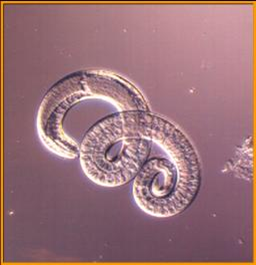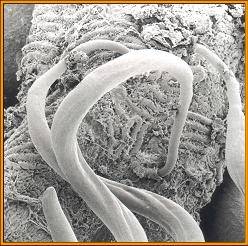BiteSized Immunology: Pathogens & Disease

Intestinal nematode parasites: mechanisms of resistance
Intestinal nematode parasites are very common infections of man and his domestic animals. When the host becomes infected, often by oral ingestion of infective eggs, the parasite establishes in its intestinal niche. Parasite antigens are carried by intestinal dendritic cells, or drain freely in the lymph, to the local draining lymph node, the mesenteric lymph node. In the mesenteric lymph node antigen is presented to T cells in the context of MHC class II. The T cell becomes polarised towards one of several possible CD4+ T cell subsets, according to the cytokine environment at the time of antigen presentation.
Elimination of intestinal nematode parasites is controlled by T helper 2 cells (Th2). Th2 cells secrete cytokines such as IL-4 and IL-13 which are capable of orchestrating the sets of effector mechanisms able to eliminate nematode infections. Typically these Th2-dependent effector responses are no good at controlling intracellular pathogens, which require a T helper 1 (Th1)-mediated response.
In order to eliminate the infection Th2 cells have to migrate from the mesenteric lymph node back to the site of infection where they control locally, through the secretion of type 2 cytokines, innate effector cells.
Examples
Trichinella spiralis (Figure 1) is a nematode parasite that lives in the small intestine. Elimination from the host involves a potent inflammatory response mediated by Th2 controlled mast cells which release proteases and other inflammatory mediators, creating an environment hostile to parasite survival.

Trichuris muris (Figure 2) is a nematode parasite that lives in the large intestine. Elimination from the host does not involve mast cells but is also Th2 controlled and thought to involve IL-13 driven changes in epithelial cell turnover and the production of goblet cell derived mucins.

Thus, although the underlying cell regulatory mechanisms required to eliminate intestinal nematodes are the same (Th2), the precise set of innate effector cells the Th2 cells orchestrate to bring about worm expulsion varies according to the species of helminth.
© The copyright for this work resides with the BSI.
